by Katerina Karavia, Kostas Papantoniou
Freedom of speech and expression is not something established in the Middle East. And the story of famous Iranian cartoonist Mana Neyestani, who has been exiled from Iran for the last 10 years, indisputably proves that. Neyestani continues to draw cartoons while in exile, depicting not only what is happening in Iran but also about what is happening in the rest of the world.
The latest conflicts in the Middle East (and especially in Syria), the refugee flows in Europe, the ISIS terrorist attacks in the heart of Europe and in many other countries are only some of the things that he is concerned about and although cartoonists are constantly being targeted by governments and conservatives, Neyestani continues his work undaunted. The result is thousands of people around the world sharing his drawings and thousands of people following him on social media.
We contacted him and asked him his opinion both on global issues and more specifically in the Middle East, this time in words instead of drawings. Neyestani gave us his perspective and helped us understand the extremely brutal reality that cartoonists experience, especially in the Middle East.
What difficulties do you encounter in your job? We have heard a lot about the Middle East…
It has been about 10 years that I live in exile. Actually I draw cartoons about Iran from outside, I try to get the news and data via Internet, to keep close to the Iranian society. Of course working in cartoon inside a totalitarian system is more risky. Dictators and authorities don’t have a sense of humour, especially if you target their benefits. Recently they sentenced “Atena Farghadani”, the Iranian cartoonist, to spend 12 years in jail. She is an Iranian feminist cartoonist who depicted the lawmakers as a bunch of donkeys and monkeys after they had decided to make a law against women rights in Iran.
Why did you choose this job?
Ιt was not like that- that I finished high school then chose cartooning among other possibilities! I was interested in cartooning since my childhood. I just continue to draw. Of course Iranian parents in 1980 believed that their children must become doctors or engineers, if they want to have a creditable job with good profit so I studied architecture designing which is a mixture of art and engineering but I have never worked as an architect, I prefer being a cartoonist.
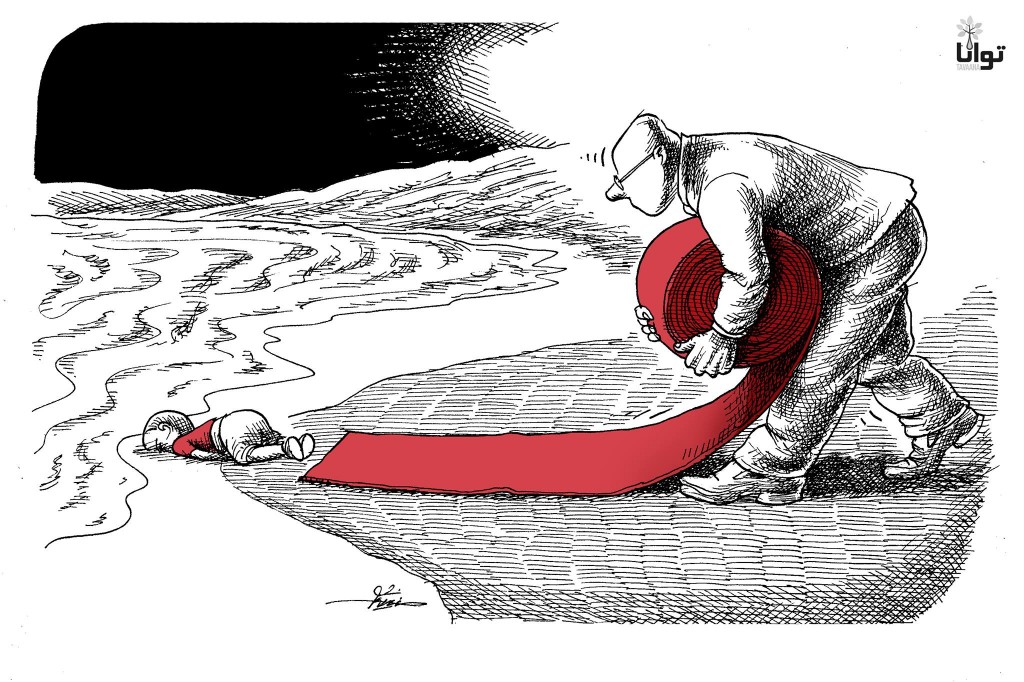
Have you ever been threatened for a sketch of yours?
In 2006 when I was working for a children section of an entertainment weekly magazine, I wrote a humorous text entitled “getting rid of cockroaches” in 9 funny methods. First method was “making a conversation with a cockroach”. I suggested to be civilised and make a dialogue before any violent act, but unfortunately cockroaches do not understand even their own language so you can kill them after. I depicted a small boy trying to make conversation in fake cockroach language with a small beetle. The poor insect does not understand it and says “Namana?” which means: “I do not understand” or “what?” . This word “namana” is used in persian informal conversations but originally it is an Azeri word (Azeris are the turk people of Iran, the biggest ethnic minority in Iran).
Unfortunately some Azeris thought that the cockroach is Azeri and that the magazine tried to humiliate them. So many people in Azeri cities came to the streets and it ended with some enormous demonstrations, the regime arrested me to make the demonstrators calm, but they continued due to the fact that they used this occasion as a pretext to protest against some official discriminations. The regime shot people dead in streets. It was a big catastrophe. After 3 months in jail they released me temporarily. I got several e-mail and phone threats so I left the country with my wife, later I made a graphic novel entitled “an Iranian metamorphosis” about this event which has been translated to French, Italian, Spanish, German, Portuguese, and English.
How did you feel when you learned that your “colleagues’’ were killed in Charlie Hebdo? Are there other cases of killings that may not have become known to the public?
I felt anger and sadness and desperate at the first moments. They (Charlie Hebdo’s cartoonists) were always a target, several times threatened by fundamentalists, but when it really happened, it was still shocking. It wasn’t the first time a cartoonist was murdered of course, we had Naji al Ali who was shot dead by anonymous people 2 decades ago. Also I remember Akram Raslan, the Syrian cartoonist who was probably killed by the Syrian regime, but that massacre in Charlie’s office was a colourful message from the fundamentalists: Dear cartoonists you are not safe, even in the heart of liberty and democracy!
Who are responsible for the war which is no longer confined to the Middle East or Africa, but has extended to Europe?
It is difficult to say, so many parameters, so many countries are involved, from middle eastern dictators like Bashar al- Assad to the fundamentalist version of Islam which has been supported by some conservative regimes, from weapon dealers to the western authorities which made the situation worst by wrong interfering, also by supporting the jihadists as an alternative for the dictators in countries like Afghanistan and Syria. You can see everybody has a share!
In Europe we see the far right getting higher popularity, and in the USA there are many chances that Donald Trump, known for his conservative views will be the next president. Why do you think people turn to more conservative politicians?
It is all a matter of security. People are afraid of terrorism and war; the rightists use this and reinforce the sense of fear and paranoia in people to get more power, but without any real and deep solution for the problem. Even in my country Iran where is surrounded by Iraq, Afganistan and Syria (all burned in civil war also dealing with ISIS and Taliban) people are afraid of getting involved in a civil or international war, therefore the regime uses this fear to legitimise their military projects and make its situation more established. Sepah (the fundamentalist military group which supported by the Iran supreme leader mr. Khamenei) shows itself as the national security guard against ISIS, and I am talking about the same Sepah which brutally suppressed the Iranian protesters six years ago in the streets! Thanks to the ISIS, the slaughterers now pretend to be heroes!
In one of your sketches, we see a man greeting someone else, who has a face-bomb. Worse than death is the fear that creates these attacks. Do you see a way for peace to come back?
Terrorism, you can tell from its name is all about making terror and fear among people. The only way is to isolate the terrorist groups and regimes (without any double standards!) as long as some western countries find “business” as their first priority, it would go nowhere!
Here some of Mana Neyestani’s draws:
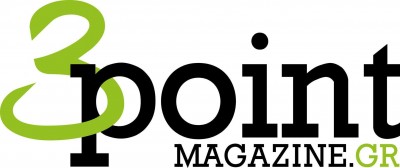
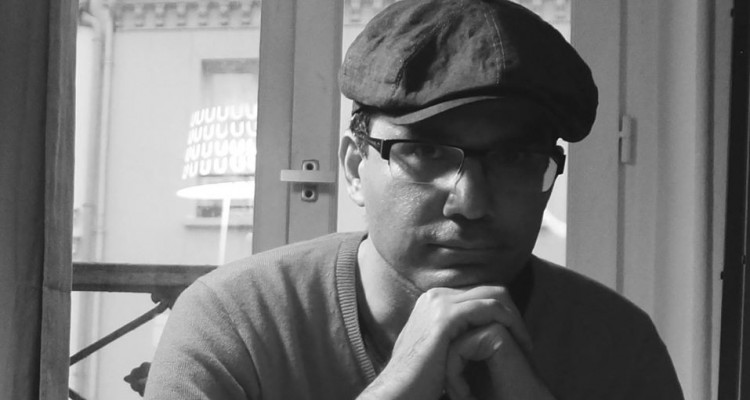




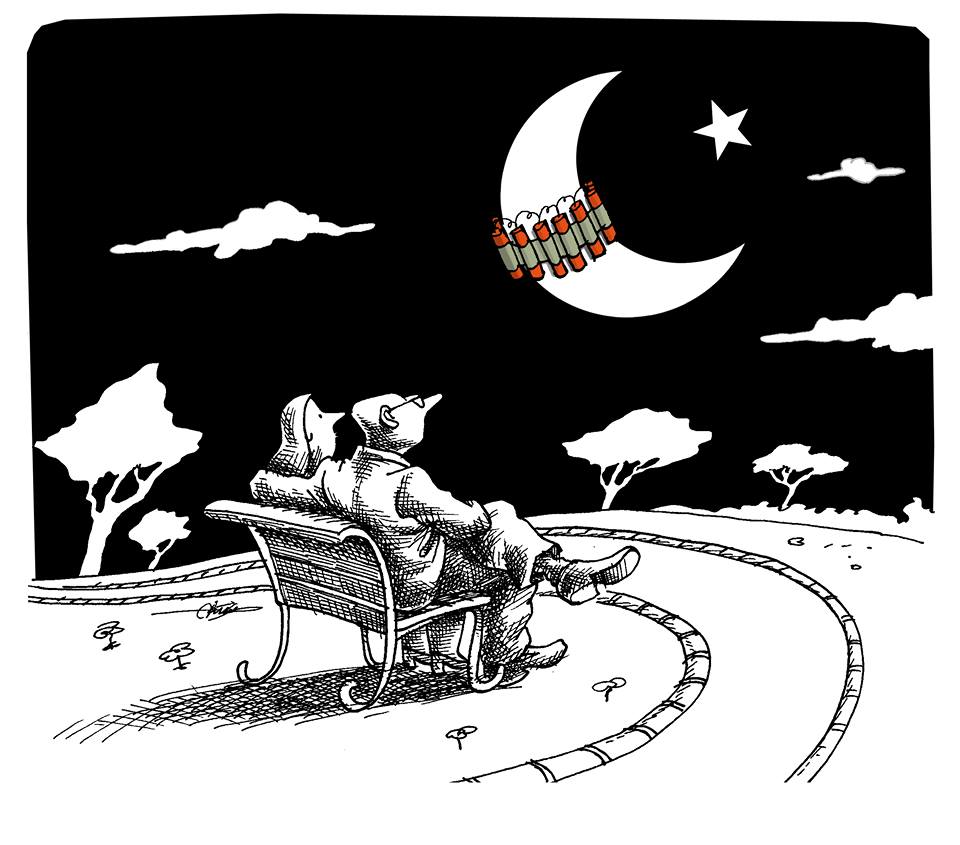
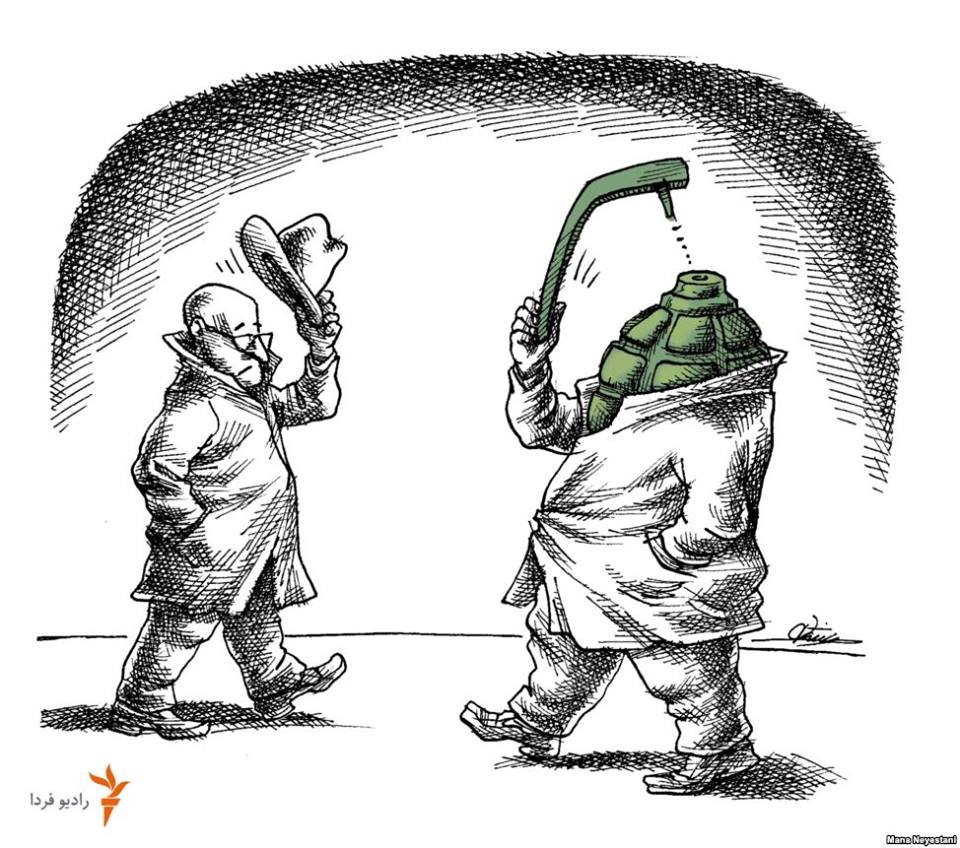
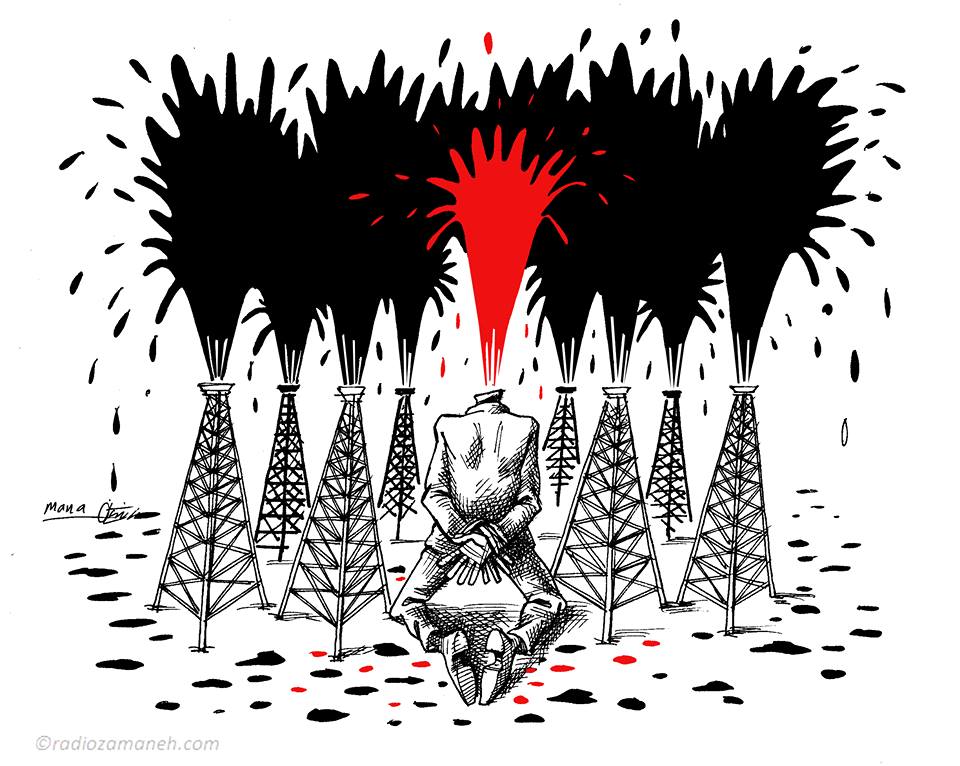
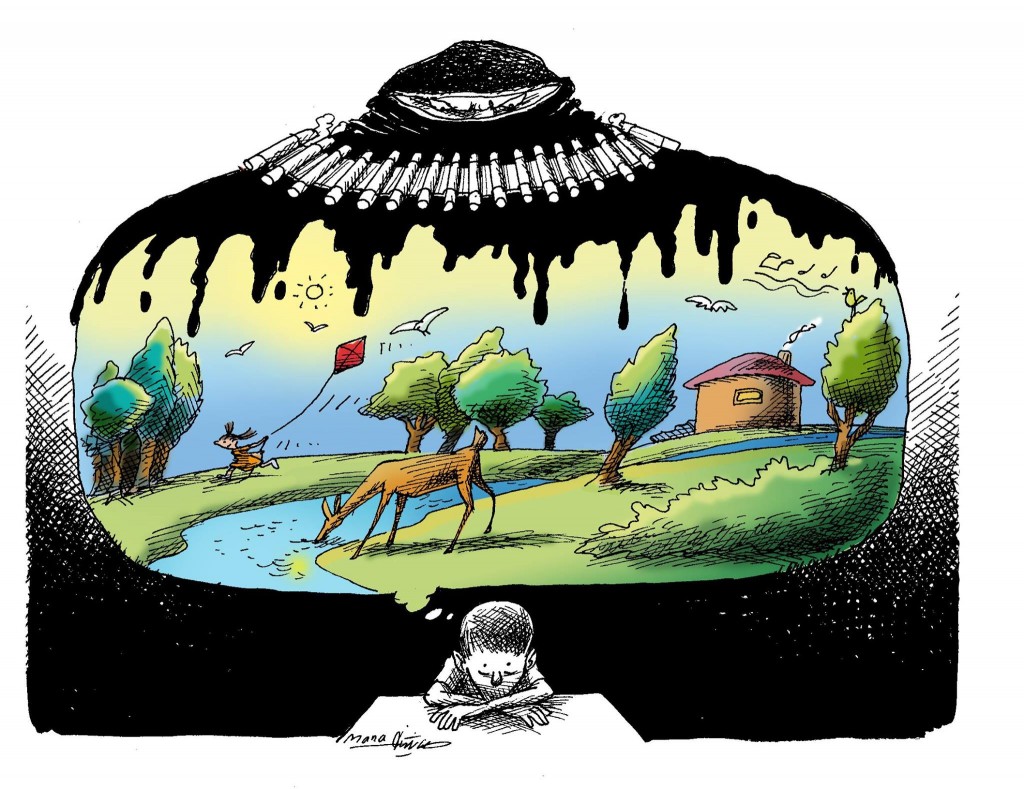

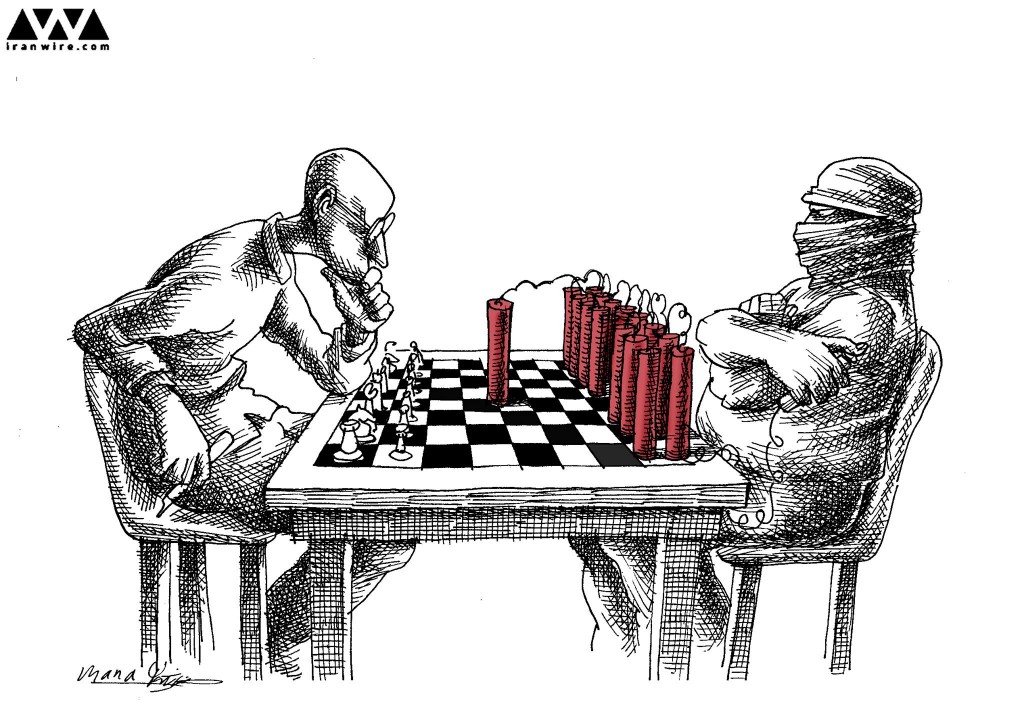
Το 3point magazine είναι ένα οριζόντια δομημένο μέσο που πιστεύει ότι η γνώμη όλων έχει αξία και επιδιώκει την έκφρασή της. Επικροτεί τα σχόλια, την κριτική και την ελεύθερη έκφραση των αναγνωστών του επιδιώκοντας την αμφίδρομη επικοινωνία μαζί τους.
Σε μια εποχή όμως που ο διάλογος τείνει να γίνεται με όρους ανθρωποφαγίας και απαξίωσης προς πρόσωπα και θεσμούς, το 3point δεν επιθυμεί να συμμετέχει. Για τον λόγο αυτόν σχόλια ρατσιστικού, υβριστικού, προσβλητικού, σεξιστικού περιεχομένου θα σβήνονται χωρίς ειδοποίηση του εκφραστή τους.
Ακόμα, το 3point magazine έχει θέσει εαυτόν απέναντι στο φασισμό και τις ποικίλες εκφράσεις του. Έτσι, σχόλια ανάλογου περιεχομένου θα έχουν την ίδια μοίρα με τα ανωτέρω, τη γνωριμία τους με το "delete".
Τέλος, τα ενυπόγραφα άρθρα εκφράζουν το συντάκτη τους και δε συμπίπτουν κατ' ανάγκην με την άποψη του 3point.